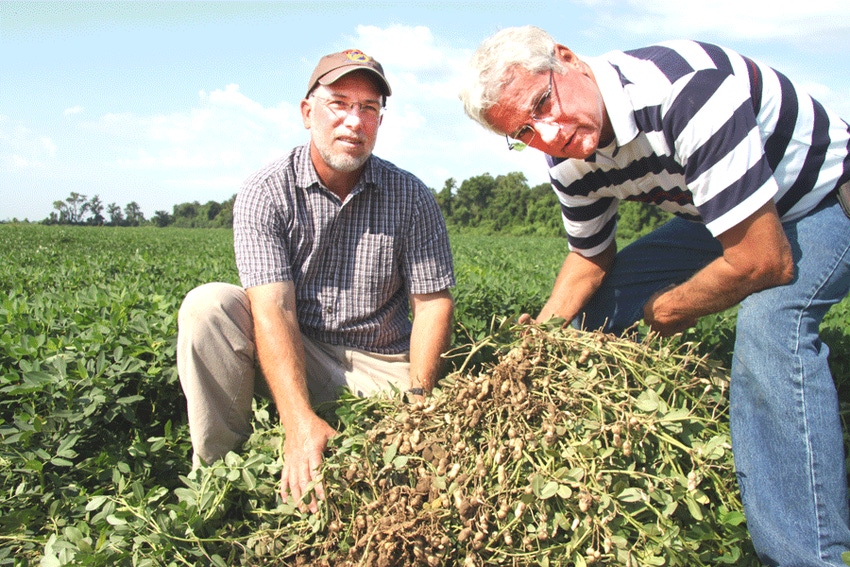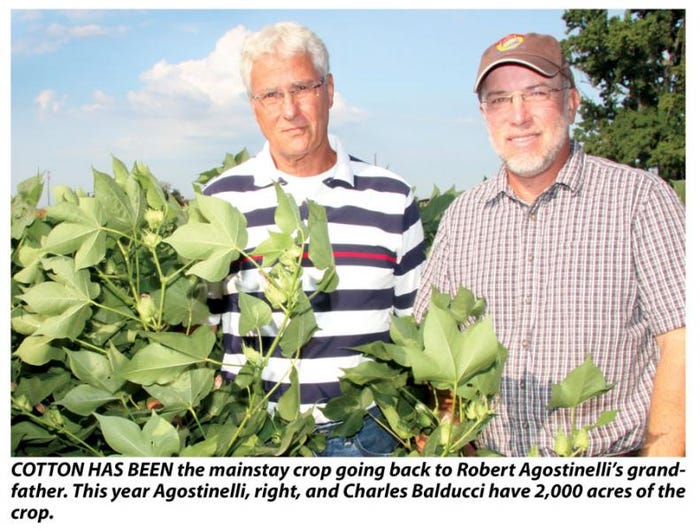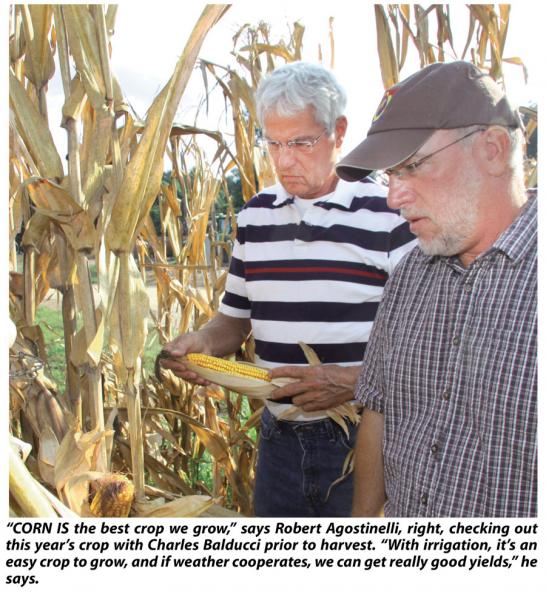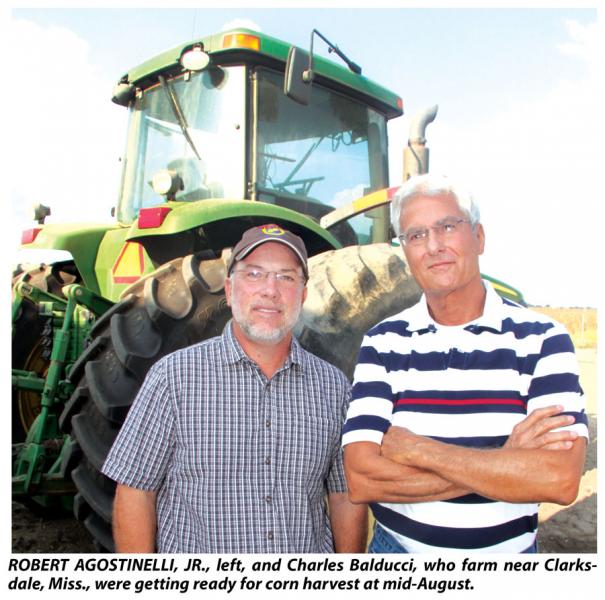
Peanuts add diversification and cotton rotation benefits for Mississippi growers
“Cotton has been our mainstay crop, going back to my father and grandfather,” says Robert Agostinelli, Jr., who farms with Charles Balducci near Clarksdale, Miss. But, this year they've added 450 acres of peanuts to their cotton/corn/soybean mix for the diversification and rotation benefits.

“I hadn’t really planned to grow peanuts this year,” says Robert Agostinelli, Jr., who farms with his brother-in-law, Charles Balducci, near Clarksdale, Miss.
“The Clint Williams Peanut Co. was holding an informational meeting for area growers earlier this year, and I went mainly out of curiosity, just to hear what they had to say,” says Agostinelli, who grew up on his father’s cotton farm and has been growing that crop all his farming career, later adding soybeans and corn.
“Their proposal was pretty interesting — basically, they were willing to book acres this year on an all-production basis at an attractive contract price. So, we ended up planting 450 acres of peanuts.”
Clint Williams currently has under construction a buying point facility at Clarksdale, said to be the largest in the U.S., and another 60 miles away at Greenwood, Miss.
“They’re putting a lot of millions into these facilities,” Agostinelli says. “With that kind of investment in infrastructure, they appear committed to the future of peanuts in the Mississippi Delta. That was another consideration in our branching out into a crop that’s totally new to us, and in spending money to buy a digger and combine for harvesting the crop.”
On the Selfs' Mississippi farm, it's wall-to-wall peanuts this year
In the 1970s, when peanuts were still under the quota system, all the acreage in Mississippi — about 6,000 acres of Spanish-type peanuts — was here in the Coahoma County area, and there was a buying point at nearby Jonestown.

Later, those allotments were sold to growers in south Mississippi, and the Delta was out of the peanut business until the quota system was eliminated in the 2002 farm bill, allowing anyone to grow the crop.
Since then, acres have been added in south Mississippi, the lower Delta, and in northeast Mississippi, but 2011’s drought-shortened crop in Texas that sent prices soaring to as much as $1,000 per ton, created widespread interest in growing peanuts.
Mississippi had the highest average peanut yield in the nation last year, and this season it’s estimated that plantings have topped 50,000 acres, more than double 2011. Much of the increase has been by Delta and east Mississippi farmers growing the crop for the first time, or those who’ve been growing peanuts a few years and added acres this year.
Aside from the attractive contract price, Agostinelli says, “We think peanuts will be an excellent rotation with our cotton under center pivots — and with cotton at 70 cents, peanuts are also a good cropping alternative.”
Peanuts need less water
And says Charles Balducci, “With increasing concerns about the declining aquifer and water conservation in the Delta, peanuts are attractive because they can get by on less water and still produce a good crop.”
Ninety percent of their peanut ground can be irrigated and in early August, on a bone dry day, with dust devils dancing across fields, their peanuts under pivot were being watered for the fourth time.
But, says Agostinelli as he spades up a plant and shows the clump of peanuts that are forming, “The peanuts have been growing vigorously, vines are pegging well, and although we have no prior experience on which to base anything, the crop looks good right now. Some Georgia growers who were here and looked at our crop said it looks better than many in their state, where peanuts have been grown for decades.”
They planted GA 06G and FLA 07 varieties, about 50-50, starting April 14 and finishing April 24. All are on their sandier land.
On Taylor farm in Arkansas, peanuts add diversity and rotation benefits
“We’ve had a little white mold,” Agostinelli says, “but fungicides seem to be suppressing that. Our first application was Headline, followed by two applications of Artisan. Since peanuts haven’t been grown in this area, we’re told we likely won’t face the heavy disease pressures they have in the Southeast.”
For weed control, their initial burndown application was Touchdown and 2,4-D. “We followed that with Ignite and Prowl for some pigweeds and marestail that had come through,” he says. “We’ve had a few glyphosate-resistant pigweeds, but we’re careful to rotate chemistry and if we see any pigweed escapes in the field, we get them pulled out immediately. Thus far, they’ve not been a significant problem.
“Behind the planter, we applied 3 oz. of Valor and 1 pint of Dual per acre, followed by 3/4 pint of Dual plus Storm. We applied 16 oz. of Select for grass control, and we’ve done some spot treating with Cobra.”
Two applications of boron were made, at 1/2 lb. per acre each time
Looking toward harvest, Agostinelli says they purchased a KMC 6-row digger and a Colombo 6-row combine.
“Based on planting date, we’re hoping to start digging about mid-September, and we’re just keeping our fingers crossed for good harvest weather, which is critical for peanuts.”
If this year’s crop turns out well, he says, and there’s a good contract price next spring, “We could comfortably expand our peanuts to 600 acres. Any increase would come out of our cotton acreage.
“Cotton has been our mainstay crop, going back to my father and grandfather,” Agostinelli says. “But if soybean and corn prices stay strong and peanut acres hold steady or expand, I expect there will be even less cotton next year.
“My grandfather, Peter, came over on the boat from Italy, and was the first to farm here, growing cotton. My father, Robert, Sr., was a farmer all his life, and he my uncle Pete taught me all I know about the business.
“My father, my brother Mark, and I farmed together after I left college. We had 600 acres between us, and Mark and I were each 25 percent partners. I had attended Delta State University, majoring in business, but I knew all the time that farming was what I wanted to do — that’s where my heart was — so I came back to the farm.
Times were tough in agriculture
“I was confronted with the necessity of either getting bigger or getting out of farming. Times were tough for agriculture in the ‘restructuring’ years of the 1980s, and a lot of people were going under or leaving farming.
“As places became available, I was fortunate to be able to get land from those who were getting out of farming. Now, you can hardly get land here; there’s a lot of competition for it, and when it becomes available it’s quite expensive.”
“About eight or nine years after I came back to the farm, my younger brother, John, was wanting to farm, too, so my father retired, the land was divided, and we set up separate operations. Mark and John began farming together, and Charles joined me here in this operation."
Charles Balducci, grew up at nearby Shelby, Miss., and came from a farming family, too.

“My father and older brother farmed,” he says, “and I farmed for 19 years before joining a die casting operation at Shelby. After I married Robert’s sister, Gina, he asked me to join him here in the farming operation, and we’ve been farming together since 1991.”
“It was a good move,” Agostinelli says. “Charles loves farming, and we work well together.”
They now have 3,700 acres in nine different farms, this year growing 2,000 acres of cotton, 850 acres of soybeans, 400 acres of corn, and 450 acres of peanuts. About 800 acres are owned, the rest rented.
They have a 10-year average for cotton of 1,250 pounds, about 180 bushels on corn, and 45 bushels on soybeans. They are also shareholders in the nearby Producers Gin of Belen.
Although Agostinelli’s heritage is steeped in cotton, which still constitutes the majority of their acreage, he says, “Corn is the best crop I’ve ever grown. With irrigation, it’s an easy crop to grow, and if weather cooperates, we can get really good yields."
They use both furrow and center pivot irrigation. “Cotton is 95 percent irrigated,” he says, “corn 100 percent, peanuts 90 percent, and soybeans 50 percent.”
Even though they’re new to peanut production, Agostinelli and Balducci agree that the crop appears to be a good fit for their operation, offering diversification and rotation benefits, along with the potential for a good return.
“It has been interesting to watch the crop develop,” Agostinelli says. “It’s a learning experience for us. Now, we’re just hoping for a good harvest.”
Peanut field day
The North Mississippi Peanut Field Day, sponsored by the Mississippi State University Extension Service will be held Aug. 29 at Clarksdale, Miss., beginning at 9 a.m. on the farm of Mark and John Agostinelli.
The farm is located in Coahoma County on Monty Martin Road off New Africa Road. Scheduled activities include speakers and a harvest demonstration. Alan Henn, Mississippi State University Extension professor of entomology and plant pathology, and Jeff Gore, assistant research professor at the Delta Research and Extension Center, will be on site to talk about current research in peanuts. Malcolm Broome, executive director of the Mississippi Peanut Growers Association, will also participate, along with Trey Bullock, peanut consultant at Hattiesburg, Miss.
For more information, contact Don Respess at (662) 624-3070, [email protected] or Judd Gentry at (662) 563-6260, [email protected].
About the Author(s)
You May Also Like



